Question of the Month
August 2015
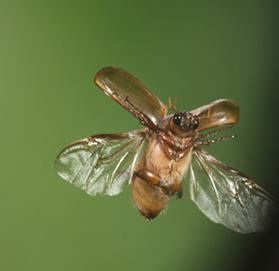
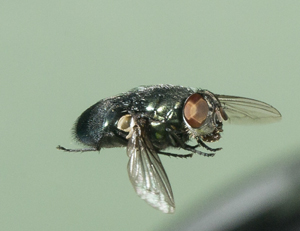
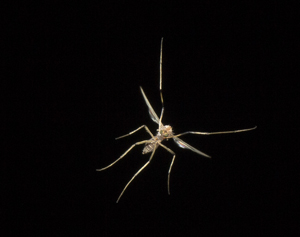
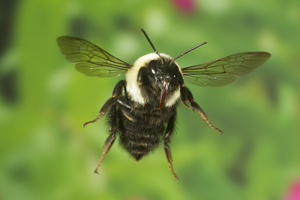
How difficult is Flying Insect Photography?
Well, last summer I tried some flying insect photography using a Range IR, where I set my camera for a 15 second exposure and the camera's drive on Continuous, to advance frames throughout the night. Sometimes an insect would break the Range IR beam which was wired to my flashes, and I'd catch the insect in flight. Provided the shutter was open during that time, as it usually was. I obtained some nice shots, and I vowed that the following summer -- 2015's -- I'd do more of this work.
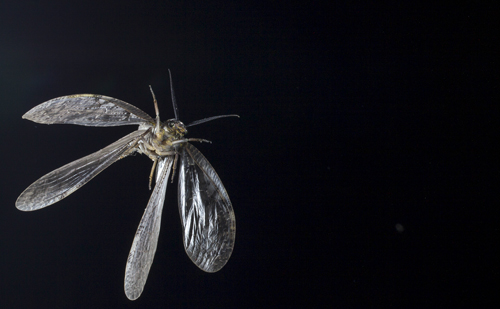
This year, however, I wanted to try diurnal insects too, and not just those that are flying at night. For that, the nocturnal setup I used with the Range IR wouldn't work, or wouldn't easily enough to not drive me crazy. The reason: for diurnal shooting (day time), the Range IR sensor would have to be wired into the camera, since long exposures would obviously overexpose the image. When wired into a camera one must deal with the camera's lag time, the time it takes for the camera to actually fire after the Range IR is triggered. With insects, an insect would be in and out of focus in millimeters, so lag time makes this virtually impossible.
However, there was a solution, and that was another Cognisys product, their Insect Rig. The rig, shown below, is a metal frame that supports two Lasers, a High Speed Shutter (explained below), the StopShot, and the camera.
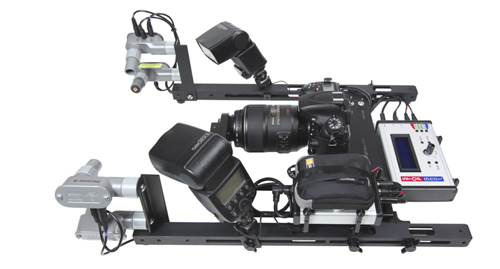

Everything is prewired so one simply needs to attach a camera and get going. Well, maybe. Here's some great tips for using this gear that will make your shooting easier, and very rewarding.
The Insect Rig comes with two brackets for mounting the Lasers that trigger the system. My mounting system for my camera raised my camera and lens so that the Laser X-beams were too low, and not centered in my lens. However, Cognisys makes a longer bracket that raises the Lasers, which allowed my lens to be aligned properly with the X of the lasers.
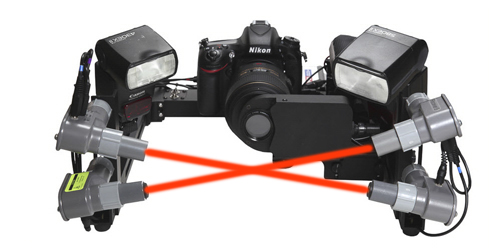
In this illustration, I am showing the X beam of the lasers, but the Lasers are on the default brackets. With the extended brackets there will be more separation between the laser and the receiver. This will allow you to use several different mounting systems, if necessary. I've added the lasers here via Photoshop, and at the actual moment of exposure the lasers turn off, so you don't record a red dot on your subject.
The camera mounts onto a platform, where a camera can be screwed on, but the mount is a dove-tail (arca-style) plate, so it is far more convenient to use a Really Right Stuff quick release clamp, either the B2-Duo or the Mini-clamp package, as either one of these will allow you to move the camera left or right to make alignment with the high speed shutter easier. Here's the two clamps:
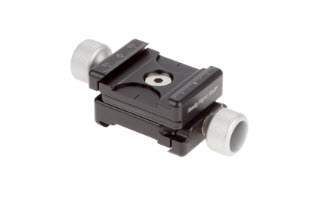
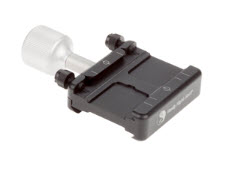
The Mini-clamp package is on the left, the B2 Duo on the right. Either one will slide on the camera platform, not only making the alignment easier but also allowing me to change camera bodies or lenses as the need arises. Get one or the other -- I was frustrated by the relatively tedious method of screwing the camera onto the plate, but with the clamps ... smooth!
You might want to consider a long camera bar to slide your camera or lens forward or back, or just a very long lens plate. This may be necessary to get the best fit with the High Speed Shutter or to position the lens for the best distance for the magnification ratio you're using.
!
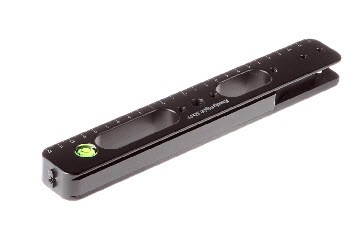
I worked on insects for several weeks, finally quitting when I had to get ready for Alaska (our bear trip) and, with August bringing cooler night time temperatures I found that a night-time setup wasn't very productive. I had an older model 100mm macro lens, and I ended up dedicating that lens to the system to free up my newer model 100mm, and I just kept that system intact for the entire duration of my project. I did some work with a 200mm, and with a 70-200, too, but for the 70-200mm zoom I was using the rig for birds! For this, I didn't use the lasers, as that would have been impossible, but I could still trigger the rig via a Range IR, which I positioned at a bait station for Blue Jays and Carolina Wrens.
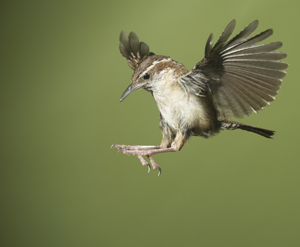
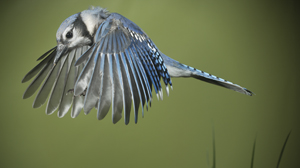
For lighting I used two Nikon SB26 flashes that I dialed down to 1/64th power, which probably gave me a 1/30,000th sec flash duration, or even shorter, which was certainly fast enough to freeze the motion of an insect, except, on occasion, the tips of the wings. Using ISOs of 400 or 800 I had apertures of f16 or so, giving me sufficient depth of field.
You might wonder how you get an insect to fly between the lasers. Cognisys makes a special mount that would allow you to carry the rig around, to approach flowers or perches, but I opted to go a lazier way. I simply baited. I used a hummingbird feeder to attract the Bumblebees, and rotting flesh (I won't go into detail) for flies and other insects -- all of these for diurnal insects. For night fliers, I used a UV light I purchased from Lowe's, and screwed that into a flood light receptacle that I positioned directly above the laser intersection.
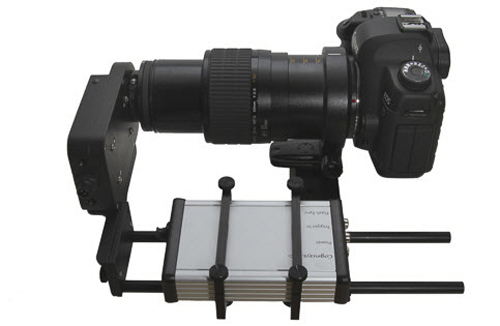
The entire rig is really dependent upon the High Speed Shutter (HSS), which eliminates the camera lag time since the HSS responds virtually instantaneously. The camera is actually set on Bulb mode, and the camera's shutter is open but the sensor isn't exposed because the external HHS acts as the shutter. When an insect breaks the X of the beams the HHS fires, and the camera, on bulb, records the shot. If an insect doesn't cross the X beam in one minute the camera advances to the next frame, which prevents noise from building up on a long exposure.
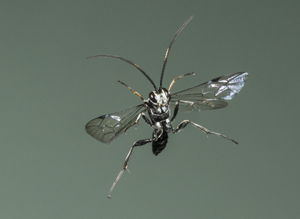
If you already own a HHS you have a major part of the Insect Rig, but if you don't, you can buy the entire system. I will confess that my first two days of using the Insect Rig were frustrating for me, and I joked that I had just shot a very expensive fly or bee! But once I got going, I started getting a lot of shots, and I was suddenly having a lot of fun.
My only final frustration was only having one HHS! The Insect Rig was proving too productive for me to take the HHS off and set up on other subjects, but once I started doing one project my mind started racing on doing others -- like jumping chipmunks or flying birds. That said, shooting the insects became extremely easy. I'd load a fresh battery and card, triple-check my focus, and walk away. Hours later I'd return to change my camera battery -- I was good for about 500 frames before the camera battery died -- and continue until early evening. Then I'd switch gears and change from my diurnal bait station to my night time set, and go again.
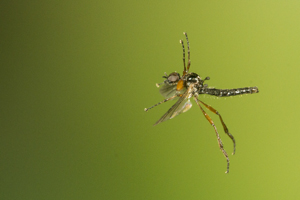 Admittedly, you will go through a lot of black frames as the camera advances frames when nothing broke the lasers. But you'll get a lot of shots, too, and at night ... some nights the flash batteries died from all the shooting, and that was at 1/64th power!
Admittedly, you will go through a lot of black frames as the camera advances frames when nothing broke the lasers. But you'll get a lot of shots, too, and at night ... some nights the flash batteries died from all the shooting, and that was at 1/64th power!
If you love insects, or want to add to your portfolio with images that VERY FEW other photographers have, I'd really consider the Insect Rig. Fall is approaching so my insect shooting in Pennsylvania is drawing to a close, but if I lived in the south, in Florida or Texas or any of the southern states, I'm sure I'd be shooting through most of the year, and the biodiversity in the south makes my northern species seem paltry in comparision! If I could take the rig to Costa Rica and the jungle ... oh man! So if I seem excited about this type of shooting, you're right. I am -- each day it was like Christmas as I opened my image browser to discover what the Insect Rig gave me, uncovering incredible hidden worlds.
If all of this talk about power ratios and shutter lag and everything else is Greek to you, consider taking our Flash course in 2016 where we'll cover these methods and provide you with a complete understanding of this important gear.
Questions of the Month
How difficult is Remote Photography?
Back Surgery - what does that have to do with photography?
How can so many people be so wrong about pumas?
What gear do you need for Antarctica?
What gear is essential for being in the field?
How Easy is NIK's HDR Program to use?
What is the most endangered big cat to photograph?
Why did we drop our NANPA membership?
What is the best $69 you can spend in photography?
More Questions about Pumas in Pennsylvania
Are the Latest Fast CF Cards worth the Expense?
How does the 7D hold up in a recent shoot?
Which is the better camera, the Mark IV or the 7D?
Are there Mountain Lions (Pumas, Cougars) in Pennsylvania and the Mid-Atlantic States?
Why is bat photography so difficult?
What do I think of the Canon 1D Mark IV?
Why do I advocate manual exposure so avidly?
Where can I find Depth of Field reference charts?
What is the Keboko backpack? Is it the New Best Pack?
Is there a correct position for the upright on a Wimberley actionhead?
How, Who, and Why? The story behind our new web site.
Archived Questions of the Month
Most of my original Questions of the Month for the last several
years are available through this link. The 'look' is from my
original web site, although if I ever have enough time I might
redo these pages to match the new web site But that's not
a high priority.
Question of the Month
August 2015




How difficult is Flying Insect Photography?
Well, last summer I tried some flying insect photography using a Range IR, where I set my camera for a 15 second exposure and the camera's drive on Continuous, to advance frames throughout the night. Sometimes an insect would break the Range IR beam which was wired to my flashes, and I'd catch the insect in flight. Provided the shutter was open during that time, as it usually was. I obtained some nice shots, and I vowed that the following summer -- 2015's -- I'd do more of this work.

This year, however, I wanted to try diurnal insects too, and not just those that are flying at night. For that, the nocturnal setup I used with the Range IR wouldn't work, or wouldn't easily enough to not drive me crazy. The reason: for diurnal shooting (day time), the Range IR sensor would have to be wired into the camera, since long exposures would obviously overexpose the image. When wired into a camera one must deal with the camera's lag time, the time it takes for the camera to actually fire after the Range IR is triggered. With insects, an insect would be in and out of focus in millimeters, so lag time makes this virtually impossible.
However, there was a solution, and that was another Cognisys product, their Insect Rig. The rig, shown below, is a metal frame that supports two Lasers, a High Speed Shutter (explained below), the StopShot, and the camera.


Everything is prewired so one simply needs to attach a camera and get going. Well, maybe. Here's some great tips for using this gear that will make your shooting easier, and very rewarding.
The Insect Rig comes with two brackets for mounting the Lasers that trigger the system. My mounting system for my camera raised my camera and lens so that the Laser X-beams were too low, and not centered in my lens. However, Cognisys makes a longer bracket that raises the Lasers, which allowed my lens to be aligned properly with the X of the lasers.

In this illustration, I am showing the X beam of the lasers, but the Lasers are on the default brackets. With the extended brackets there will be more separation between the laser and the receiver. This will allow you to use several different mounting systems, if necessary. I've added the lasers here via Photoshop, and at the actual moment of exposure the lasers turn off, so you don't record a red dot on your subject.
The camera mounts onto a platform, where a camera can be screwed on, but the mount is a dove-tail (arca-style) plate, so it is far more convenient to use a Really Right Stuff quick release clamp, either the B2-Duo or the Mini-clamp package, as either one of these will allow you to move the camera left or right to make alignment with the high speed shutter easier. Here's the two clamps:


The Mini-clamp package is on the left, the B2 Duo on the right. Either one will slide on the camera platform, not only making the alignment easier but also allowing me to change camera bodies or lenses as the need arises. Get one or the other -- I was frustrated by the relatively tedious method of screwing the camera onto the plate, but with the clamps ... smooth!
You might want to consider a long camera bar to slide your camera or lens forward or back, or just a very long lens plate. This may be necessary to get the best fit with the High Speed Shutter or to position the lens for the best distance for the magnification ratio you're using.
!

I worked on insects for several weeks, finally quitting when I had to get ready for Alaska (our bear trip) and, with August bringing cooler night time temperatures I found that a night-time setup wasn't very productive. I had an older model 100mm macro lens, and I ended up dedicating that lens to the system to free up my newer model 100mm, and I just kept that system intact for the entire duration of my project. I did some work with a 200mm, and with a 70-200, too, but for the 70-200mm zoom I was using the rig for birds! For this, I didn't use the lasers, as that would have been impossible, but I could still trigger the rig via a Range IR, which I positioned at a bait station for Blue Jays and Carolina Wrens.


For lighting I used two Nikon SB26 flashes that I dialed down to 1/64th power, which probably gave me a 1/30,000th sec flash duration, or even shorter, which was certainly fast enough to freeze the motion of an insect, except, on occasion, the tips of the wings. Using ISOs of 400 or 800 I had apertures of f16 or so, giving me sufficient depth of field.
You might wonder how you get an insect to fly between the lasers. Cognisys makes a special mount that would allow you to carry the rig around, to approach flowers or perches, but I opted to go a lazier way. I simply baited. I used a hummingbird feeder to attract the Bumblebees, and rotting flesh (I won't go into detail) for flies and other insects -- all of these for diurnal insects. For night fliers, I used a UV light I purchased from Lowe's, and screwed that into a flood light receptacle that I positioned directly above the laser intersection.

The entire rig is really dependent upon the High Speed Shutter (HSS), which eliminates the camera lag time since the HSS responds virtually instantaneously. The camera is actually set on Bulb mode, and the camera's shutter is open but the sensor isn't exposed because the external HHS acts as the shutter. When an insect breaks the X of the beams the HHS fires, and the camera, on bulb, records the shot. If an insect doesn't cross the X beam in one minute the camera advances to the next frame, which prevents noise from building up on a long exposure.

If you already own a HHS you have a major part of the Insect Rig, but if you don't, you can buy the entire system. I will confess that my first two days of using the Insect Rig were frustrating for me, and I joked that I had just shot a very expensive fly or bee! But once I got going, I started getting a lot of shots, and I was suddenly having a lot of fun.
My only final frustration was only having one HHS! The Insect Rig was proving too productive for me to take the HHS off and set up on other subjects, but once I started doing one project my mind started racing on doing others -- like jumping chipmunks or flying birds. That said, shooting the insects became extremely easy. I'd load a fresh battery and card, triple-check my focus, and walk away. Hours later I'd return to change my camera battery -- I was good for about 500 frames before the camera battery died -- and continue until early evening. Then I'd switch gears and change from my diurnal bait station to my night time set, and go again.
 Admittedly, you will go through a lot of black frames as the camera advances frames when nothing broke the lasers. But you'll get a lot of shots, too, and at night ... some nights the flash batteries died from all the shooting, and that was at 1/64th power!
Admittedly, you will go through a lot of black frames as the camera advances frames when nothing broke the lasers. But you'll get a lot of shots, too, and at night ... some nights the flash batteries died from all the shooting, and that was at 1/64th power!
If you love insects, or want to add to your portfolio with images that VERY FEW other photographers have, I'd really consider the Insect Rig. Fall is approaching so my insect shooting in Pennsylvania is drawing to a close, but if I lived in the south, in Florida or Texas or any of the southern states, I'm sure I'd be shooting through most of the year, and the biodiversity in the south makes my northern species seem paltry in comparision! If I could take the rig to Costa Rica and the jungle ... oh man! So if I seem excited about this type of shooting, you're right. I am -- each day it was like Christmas as I opened my image browser to discover what the Insect Rig gave me, uncovering incredible hidden worlds.
If all of this talk about power ratios and shutter lag and everything else is Greek to you, consider taking our Flash course in 2016 where we'll cover these methods and provide you with a complete understanding of this important gear.
Questions of the Month
How difficult is Remote Photography?
Back Surgery - what does that have to do with photography?
How can so many people be so wrong about pumas?
What gear do you need for Antarctica?
What gear is essential for being in the field?
How Easy is NIK's HDR Program to use?
What is the most endangered big cat to photograph?
Why did we drop our NANPA membership?
What is the best $69 you can spend in photography?
More Questions about Pumas in Pennsylvania
Are the Latest Fast CF Cards worth the Expense?
How does the 7D hold up in a recent shoot?
Which is the better camera, the Mark IV or the 7D?
Are there Mountain Lions (Pumas, Cougars) in Pennsylvania and the Mid-Atlantic States?
Why is bat photography so difficult?
What do I think of the Canon 1D Mark IV?
Why do I advocate manual exposure so avidly?
Where can I find Depth of Field reference charts?
What is the Keboko backpack? Is it the New Best Pack?
Is there a correct position for the upright on a Wimberley actionhead?
How, Who, and Why? The story behind our new web site.
Archived Questions of the Month
Most of my original Questions of the Month for the last several
years are available through this link. The 'look' is from my
original web site, although if I ever have enough time I might
redo these pages to match the new web site But that's not
a high priority.
Question of the Month
August 2015




How difficult is Flying Insect Photography?
Well, last summer I tried some flying insect photography using a Range IR, where I set my camera for a 15 second exposure and the camera's drive on Continuous, to advance frames throughout the night. Sometimes an insect would break the Range IR beam which was wired to my flashes, and I'd catch the insect in flight. Provided the shutter was open during that time, as it usually was. I obtained some nice shots, and I vowed that the following summer -- 2015's -- I'd do more of this work.

This year, however, I wanted to try diurnal insects too, and not just those that are flying at night. For that, the nocturnal setup I used with the Range IR wouldn't work, or wouldn't easily enough to not drive me crazy. The reason: for diurnal shooting (day time), the Range IR sensor would have to be wired into the camera, since long exposures would obviously overexpose the image. When wired into a camera one must deal with the camera's lag time, the time it takes for the camera to actually fire after the Range IR is triggered. With insects, an insect would be in and out of focus in millimeters, so lag time makes this virtually impossible.
However, there was a solution, and that was another Cognisys product, their Insect Rig. The rig, shown below, is a metal frame that supports two Lasers, a High Speed Shutter (explained below), the StopShot, and the camera.


Everything is prewired so one simply needs to attach a camera and get going. Well, maybe. Here's some great tips for using this gear that will make your shooting easier, and very rewarding.
The Insect Rig comes with two brackets for mounting the Lasers that trigger the system. My mounting system for my camera raised my camera and lens so that the Laser X-beams were too low, and not centered in my lens. However, Cognisys makes a longer bracket that raises the Lasers, which allowed my lens to be aligned properly with the X of the lasers.

In this illustration, I am showing the X beam of the lasers, but the Lasers are on the default brackets. With the extended brackets there will be more separation between the laser and the receiver. This will allow you to use several different mounting systems, if necessary. I've added the lasers here via Photoshop, and at the actual moment of exposure the lasers turn off, so you don't record a red dot on your subject.
The camera mounts onto a platform, where a camera can be screwed on, but the mount is a dove-tail (arca-style) plate, so it is far more convenient to use a Really Right Stuff quick release clamp, either the B2-Duo or the Mini-clamp package, as either one of these will allow you to move the camera left or right to make alignment with the high speed shutter easier. Here's the two clamps:


The Mini-clamp package is on the left, the B2 Duo on the right. Either one will slide on the camera platform, not only making the alignment easier but also allowing me to change camera bodies or lenses as the need arises. Get one or the other -- I was frustrated by the relatively tedious method of screwing the camera onto the plate, but with the clamps ... smooth!
You might want to consider a long camera bar to slide your camera or lens forward or back, or just a very long lens plate. This may be necessary to get the best fit with the High Speed Shutter or to position the lens for the best distance for the magnification ratio you're using.
!

I worked on insects for several weeks, finally quitting when I had to get ready for Alaska (our bear trip) and, with August bringing cooler night time temperatures I found that a night-time setup wasn't very productive. I had an older model 100mm macro lens, and I ended up dedicating that lens to the system to free up my newer model 100mm, and I just kept that system intact for the entire duration of my project. I did some work with a 200mm, and with a 70-200, too, but for the 70-200mm zoom I was using the rig for birds! For this, I didn't use the lasers, as that would have been impossible, but I could still trigger the rig via a Range IR, which I positioned at a bait station for Blue Jays and Carolina Wrens.


For lighting I used two Nikon SB26 flashes that I dialed down to 1/64th power, which probably gave me a 1/30,000th sec flash duration, or even shorter, which was certainly fast enough to freeze the motion of an insect, except, on occasion, the tips of the wings. Using ISOs of 400 or 800 I had apertures of f16 or so, giving me sufficient depth of field.
You might wonder how you get an insect to fly between the lasers. Cognisys makes a special mount that would allow you to carry the rig around, to approach flowers or perches, but I opted to go a lazier way. I simply baited. I used a hummingbird feeder to attract the Bumblebees, and rotting flesh (I won't go into detail) for flies and other insects -- all of these for diurnal insects. For night fliers, I used a UV light I purchased from Lowe's, and screwed that into a flood light receptacle that I positioned directly above the laser intersection.

The entire rig is really dependent upon the High Speed Shutter (HSS), which eliminates the camera lag time since the HSS responds virtually instantaneously. The camera is actually set on Bulb mode, and the camera's shutter is open but the sensor isn't exposed because the external HHS acts as the shutter. When an insect breaks the X of the beams the HHS fires, and the camera, on bulb, records the shot. If an insect doesn't cross the X beam in one minute the camera advances to the next frame, which prevents noise from building up on a long exposure.

If you already own a HHS you have a major part of the Insect Rig, but if you don't, you can buy the entire system. I will confess that my first two days of using the Insect Rig were frustrating for me, and I joked that I had just shot a very expensive fly or bee! But once I got going, I started getting a lot of shots, and I was suddenly having a lot of fun.
My only final frustration was only having one HHS! The Insect Rig was proving too productive for me to take the HHS off and set up on other subjects, but once I started doing one project my mind started racing on doing others -- like jumping chipmunks or flying birds. That said, shooting the insects became extremely easy. I'd load a fresh battery and card, triple-check my focus, and walk away. Hours later I'd return to change my camera battery -- I was good for about 500 frames before the camera battery died -- and continue until early evening. Then I'd switch gears and change from my diurnal bait station to my night time set, and go again.
 Admittedly, you will go through a lot of black frames as the camera advances frames when nothing broke the lasers. But you'll get a lot of shots, too, and at night ... some nights the flash batteries died from all the shooting, and that was at 1/64th power!
Admittedly, you will go through a lot of black frames as the camera advances frames when nothing broke the lasers. But you'll get a lot of shots, too, and at night ... some nights the flash batteries died from all the shooting, and that was at 1/64th power!
If you love insects, or want to add to your portfolio with images that VERY FEW other photographers have, I'd really consider the Insect Rig. Fall is approaching so my insect shooting in Pennsylvania is drawing to a close, but if I lived in the south, in Florida or Texas or any of the southern states, I'm sure I'd be shooting through most of the year, and the biodiversity in the south makes my northern species seem paltry in comparision! If I could take the rig to Costa Rica and the jungle ... oh man! So if I seem excited about this type of shooting, you're right. I am -- each day it was like Christmas as I opened my image browser to discover what the Insect Rig gave me, uncovering incredible hidden worlds.
If all of this talk about power ratios and shutter lag and everything else is Greek to you, consider taking our Flash course in 2016 where we'll cover these methods and provide you with a complete understanding of this important gear.
Questions of the Month
How difficult is Remote Photography?
Back Surgery - what does that have to do with photography?
How can so many people be so wrong about pumas?
What gear do you need for Antarctica?
What gear is essential for being in the field?
How Easy is NIK's HDR Program to use?
What is the most endangered big cat to photograph?
Why did we drop our NANPA membership?
What is the best $69 you can spend in photography?
More Questions about Pumas in Pennsylvania
Are the Latest Fast CF Cards worth the Expense?
How does the 7D hold up in a recent shoot?
Which is the better camera, the Mark IV or the 7D?
Are there Mountain Lions (Pumas, Cougars) in Pennsylvania and the Mid-Atlantic States?
Why is bat photography so difficult?
What do I think of the Canon 1D Mark IV?
Why do I advocate manual exposure so avidly?
Where can I find Depth of Field reference charts?
What is the Keboko backpack? Is it the New Best Pack?
Is there a correct position for the upright on a Wimberley actionhead?
How, Who, and Why? The story behind our new web site.
Archived Questions of the Month
Most of my original Questions of the Month for the last several
years are available through this link. The 'look' is from my
original web site, although if I ever have enough time I might
redo these pages to match the new web site But that's not
a high priority.
Question of the Month
August 2015




How difficult is Flying Insect Photography?
Well, last summer I tried some flying insect photography using a Range IR, where I set my camera for a 15 second exposure and the camera's drive on Continuous, to advance frames throughout the night. Sometimes an insect would break the Range IR beam which was wired to my flashes, and I'd catch the insect in flight. Provided the shutter was open during that time, as it usually was. I obtained some nice shots, and I vowed that the following summer -- 2015's -- I'd do more of this work.

This year, however, I wanted to try diurnal insects too, and not just those that are flying at night. For that, the nocturnal setup I used with the Range IR wouldn't work, or wouldn't easily enough to not drive me crazy. The reason: for diurnal shooting (day time), the Range IR sensor would have to be wired into the camera, since long exposures would obviously overexpose the image. When wired into a camera one must deal with the camera's lag time, the time it takes for the camera to actually fire after the Range IR is triggered. With insects, an insect would be in and out of focus in millimeters, so lag time makes this virtually impossible.
However, there was a solution, and that was another Cognisys product, their Insect Rig. The rig, shown below, is a metal frame that supports two Lasers, a High Speed Shutter (explained below), the StopShot, and the camera.


Everything is prewired so one simply needs to attach a camera and get going. Well, maybe. Here's some great tips for using this gear that will make your shooting easier, and very rewarding.
The Insect Rig comes with two brackets for mounting the Lasers that trigger the system. My mounting system for my camera raised my camera and lens so that the Laser X-beams were too low, and not centered in my lens. However, Cognisys makes a longer bracket that raises the Lasers, which allowed my lens to be aligned properly with the X of the lasers.

In this illustration, I am showing the X beam of the lasers, but the Lasers are on the default brackets. With the extended brackets there will be more separation between the laser and the receiver. This will allow you to use several different mounting systems, if necessary. I've added the lasers here via Photoshop, and at the actual moment of exposure the lasers turn off, so you don't record a red dot on your subject.
The camera mounts onto a platform, where a camera can be screwed on, but the mount is a dove-tail (arca-style) plate, so it is far more convenient to use a Really Right Stuff quick release clamp, either the B2-Duo or the Mini-clamp package, as either one of these will allow you to move the camera left or right to make alignment with the high speed shutter easier. Here's the two clamps:


The Mini-clamp package is on the left, the B2 Duo on the right. Either one will slide on the camera platform, not only making the alignment easier but also allowing me to change camera bodies or lenses as the need arises. Get one or the other -- I was frustrated by the relatively tedious method of screwing the camera onto the plate, but with the clamps ... smooth!
You might want to consider a long camera bar to slide your camera or lens forward or back, or just a very long lens plate. This may be necessary to get the best fit with the High Speed Shutter or to position the lens for the best distance for the magnification ratio you're using.
!

I worked on insects for several weeks, finally quitting when I had to get ready for Alaska (our bear trip) and, with August bringing cooler night time temperatures I found that a night-time setup wasn't very productive. I had an older model 100mm macro lens, and I ended up dedicating that lens to the system to free up my newer model 100mm, and I just kept that system intact for the entire duration of my project. I did some work with a 200mm, and with a 70-200, too, but for the 70-200mm zoom I was using the rig for birds! For this, I didn't use the lasers, as that would have been impossible, but I could still trigger the rig via a Range IR, which I positioned at a bait station for Blue Jays and Carolina Wrens.


For lighting I used two Nikon SB26 flashes that I dialed down to 1/64th power, which probably gave me a 1/30,000th sec flash duration, or even shorter, which was certainly fast enough to freeze the motion of an insect, except, on occasion, the tips of the wings. Using ISOs of 400 or 800 I had apertures of f16 or so, giving me sufficient depth of field.
You might wonder how you get an insect to fly between the lasers. Cognisys makes a special mount that would allow you to carry the rig around, to approach flowers or perches, but I opted to go a lazier way. I simply baited. I used a hummingbird feeder to attract the Bumblebees, and rotting flesh (I won't go into detail) for flies and other insects -- all of these for diurnal insects. For night fliers, I used a UV light I purchased from Lowe's, and screwed that into a flood light receptacle that I positioned directly above the laser intersection.

The entire rig is really dependent upon the High Speed Shutter (HSS), which eliminates the camera lag time since the HSS responds virtually instantaneously. The camera is actually set on Bulb mode, and the camera's shutter is open but the sensor isn't exposed because the external HHS acts as the shutter. When an insect breaks the X of the beams the HHS fires, and the camera, on bulb, records the shot. If an insect doesn't cross the X beam in one minute the camera advances to the next frame, which prevents noise from building up on a long exposure.

If you already own a HHS you have a major part of the Insect Rig, but if you don't, you can buy the entire system. I will confess that my first two days of using the Insect Rig were frustrating for me, and I joked that I had just shot a very expensive fly or bee! But once I got going, I started getting a lot of shots, and I was suddenly having a lot of fun.
My only final frustration was only having one HHS! The Insect Rig was proving too productive for me to take the HHS off and set up on other subjects, but once I started doing one project my mind started racing on doing others -- like jumping chipmunks or flying birds. That said, shooting the insects became extremely easy. I'd load a fresh battery and card, triple-check my focus, and walk away. Hours later I'd return to change my camera battery -- I was good for about 500 frames before the camera battery died -- and continue until early evening. Then I'd switch gears and change from my diurnal bait station to my night time set, and go again.
 Admittedly, you will go through a lot of black frames as the camera advances frames when nothing broke the lasers. But you'll get a lot of shots, too, and at night ... some nights the flash batteries died from all the shooting, and that was at 1/64th power!
Admittedly, you will go through a lot of black frames as the camera advances frames when nothing broke the lasers. But you'll get a lot of shots, too, and at night ... some nights the flash batteries died from all the shooting, and that was at 1/64th power!
If you love insects, or want to add to your portfolio with images that VERY FEW other photographers have, I'd really consider the Insect Rig. Fall is approaching so my insect shooting in Pennsylvania is drawing to a close, but if I lived in the south, in Florida or Texas or any of the southern states, I'm sure I'd be shooting through most of the year, and the biodiversity in the south makes my northern species seem paltry in comparision! If I could take the rig to Costa Rica and the jungle ... oh man! So if I seem excited about this type of shooting, you're right. I am -- each day it was like Christmas as I opened my image browser to discover what the Insect Rig gave me, uncovering incredible hidden worlds.
If all of this talk about power ratios and shutter lag and everything else is Greek to you, consider taking our Flash course in 2016 where we'll cover these methods and provide you with a complete understanding of this important gear.
Questions of the Month
How difficult is Remote Photography?
Back Surgery - what does that have to do with photography?
How can so many people be so wrong about pumas?
What gear do you need for Antarctica?
What gear is essential for being in the field?
How Easy is NIK's HDR Program to use?
What is the most endangered big cat to photograph?
Why did we drop our NANPA membership?
What is the best $69 you can spend in photography?
More Questions about Pumas in Pennsylvania
Are the Latest Fast CF Cards worth the Expense?
How does the 7D hold up in a recent shoot?
Which is the better camera, the Mark IV or the 7D?
Are there Mountain Lions (Pumas, Cougars) in Pennsylvania and the Mid-Atlantic States?
Why is bat photography so difficult?
What do I think of the Canon 1D Mark IV?
Why do I advocate manual exposure so avidly?
Where can I find Depth of Field reference charts?
What is the Keboko backpack? Is it the New Best Pack?
Is there a correct position for the upright on a Wimberley actionhead?
How, Who, and Why? The story behind our new web site.
Archived Questions of the Month
Most of my original Questions of the Month for the last several
years are available through this link. The 'look' is from my
original web site, although if I ever have enough time I might
redo these pages to match the new web site But that's not
a high priority.
Question of the Month
August 2015




How difficult is Flying Insect Photography?
Well, last summer I tried some flying insect photography using a Range IR, where I set my camera for a 15 second exposure and the camera's drive on Continuous, to advance frames throughout the night. Sometimes an insect would break the Range IR beam which was wired to my flashes, and I'd catch the insect in flight. Provided the shutter was open during that time, as it usually was. I obtained some nice shots, and I vowed that the following summer -- 2015's -- I'd do more of this work.

This year, however, I wanted to try diurnal insects too, and not just those that are flying at night. For that, the nocturnal setup I used with the Range IR wouldn't work, or wouldn't easily enough to not drive me crazy. The reason: for diurnal shooting (day time), the Range IR sensor would have to be wired into the camera, since long exposures would obviously overexpose the image. When wired into a camera one must deal with the camera's lag time, the time it takes for the camera to actually fire after the Range IR is triggered. With insects, an insect would be in and out of focus in millimeters, so lag time makes this virtually impossible.
However, there was a solution, and that was another Cognisys product, their Insect Rig. The rig, shown below, is a metal frame that supports two Lasers, a High Speed Shutter (explained below), the StopShot, and the camera.


Everything is prewired so one simply needs to attach a camera and get going. Well, maybe. Here's some great tips for using this gear that will make your shooting easier, and very rewarding.
The Insect Rig comes with two brackets for mounting the Lasers that trigger the system. My mounting system for my camera raised my camera and lens so that the Laser X-beams were too low, and not centered in my lens. However, Cognisys makes a longer bracket that raises the Lasers, which allowed my lens to be aligned properly with the X of the lasers.

In this illustration, I am showing the X beam of the lasers, but the Lasers are on the default brackets. With the extended brackets there will be more separation between the laser and the receiver. This will allow you to use several different mounting systems, if necessary. I've added the lasers here via Photoshop, and at the actual moment of exposure the lasers turn off, so you don't record a red dot on your subject.
The camera mounts onto a platform, where a camera can be screwed on, but the mount is a dove-tail (arca-style) plate, so it is far more convenient to use a Really Right Stuff quick release clamp, either the B2-Duo or the Mini-clamp package, as either one of these will allow you to move the camera left or right to make alignment with the high speed shutter easier. Here's the two clamps:


The Mini-clamp package is on the left, the B2 Duo on the right. Either one will slide on the camera platform, not only making the alignment easier but also allowing me to change camera bodies or lenses as the need arises. Get one or the other -- I was frustrated by the relatively tedious method of screwing the camera onto the plate, but with the clamps ... smooth!
You might want to consider a long camera bar to slide your camera or lens forward or back, or just a very long lens plate. This may be necessary to get the best fit with the High Speed Shutter or to position the lens for the best distance for the magnification ratio you're using.
!

I worked on insects for several weeks, finally quitting when I had to get ready for Alaska (our bear trip) and, with August bringing cooler night time temperatures I found that a night-time setup wasn't very productive. I had an older model 100mm macro lens, and I ended up dedicating that lens to the system to free up my newer model 100mm, and I just kept that system intact for the entire duration of my project. I did some work with a 200mm, and with a 70-200, too, but for the 70-200mm zoom I was using the rig for birds! For this, I didn't use the lasers, as that would have been impossible, but I could still trigger the rig via a Range IR, which I positioned at a bait station for Blue Jays and Carolina Wrens.


For lighting I used two Nikon SB26 flashes that I dialed down to 1/64th power, which probably gave me a 1/30,000th sec flash duration, or even shorter, which was certainly fast enough to freeze the motion of an insect, except, on occasion, the tips of the wings. Using ISOs of 400 or 800 I had apertures of f16 or so, giving me sufficient depth of field.
You might wonder how you get an insect to fly between the lasers. Cognisys makes a special mount that would allow you to carry the rig around, to approach flowers or perches, but I opted to go a lazier way. I simply baited. I used a hummingbird feeder to attract the Bumblebees, and rotting flesh (I won't go into detail) for flies and other insects -- all of these for diurnal insects. For night fliers, I used a UV light I purchased from Lowe's, and screwed that into a flood light receptacle that I positioned directly above the laser intersection.

The entire rig is really dependent upon the High Speed Shutter (HSS), which eliminates the camera lag time since the HSS responds virtually instantaneously. The camera is actually set on Bulb mode, and the camera's shutter is open but the sensor isn't exposed because the external HHS acts as the shutter. When an insect breaks the X of the beams the HHS fires, and the camera, on bulb, records the shot. If an insect doesn't cross the X beam in one minute the camera advances to the next frame, which prevents noise from building up on a long exposure.

If you already own a HHS you have a major part of the Insect Rig, but if you don't, you can buy the entire system. I will confess that my first two days of using the Insect Rig were frustrating for me, and I joked that I had just shot a very expensive fly or bee! But once I got going, I started getting a lot of shots, and I was suddenly having a lot of fun.
My only final frustration was only having one HHS! The Insect Rig was proving too productive for me to take the HHS off and set up on other subjects, but once I started doing one project my mind started racing on doing others -- like jumping chipmunks or flying birds. That said, shooting the insects became extremely easy. I'd load a fresh battery and card, triple-check my focus, and walk away. Hours later I'd return to change my camera battery -- I was good for about 500 frames before the camera battery died -- and continue until early evening. Then I'd switch gears and change from my diurnal bait station to my night time set, and go again.
 Admittedly, you will go through a lot of black frames as the camera advances frames when nothing broke the lasers. But you'll get a lot of shots, too, and at night ... some nights the flash batteries died from all the shooting, and that was at 1/64th power!
Admittedly, you will go through a lot of black frames as the camera advances frames when nothing broke the lasers. But you'll get a lot of shots, too, and at night ... some nights the flash batteries died from all the shooting, and that was at 1/64th power!
If you love insects, or want to add to your portfolio with images that VERY FEW other photographers have, I'd really consider the Insect Rig. Fall is approaching so my insect shooting in Pennsylvania is drawing to a close, but if I lived in the south, in Florida or Texas or any of the southern states, I'm sure I'd be shooting through most of the year, and the biodiversity in the south makes my northern species seem paltry in comparision! If I could take the rig to Costa Rica and the jungle ... oh man! So if I seem excited about this type of shooting, you're right. I am -- each day it was like Christmas as I opened my image browser to discover what the Insect Rig gave me, uncovering incredible hidden worlds.
If all of this talk about power ratios and shutter lag and everything else is Greek to you, consider taking our Flash course in 2016 where we'll cover these methods and provide you with a complete understanding of this important gear.
Questions of the Month
How difficult is Remote Photography?
Back Surgery - what does that have to do with photography?
How can so many people be so wrong about pumas?
What gear do you need for Antarctica?
What gear is essential for being in the field?
How Easy is NIK's HDR Program to use?
What is the most endangered big cat to photograph?
Why did we drop our NANPA membership?
What is the best $69 you can spend in photography?
More Questions about Pumas in Pennsylvania
Are the Latest Fast CF Cards worth the Expense?
How does the 7D hold up in a recent shoot?
Which is the better camera, the Mark IV or the 7D?
Are there Mountain Lions (Pumas, Cougars) in Pennsylvania and the Mid-Atlantic States?
Why is bat photography so difficult?
What do I think of the Canon 1D Mark IV?
Why do I advocate manual exposure so avidly?
Where can I find Depth of Field reference charts?
What is the Keboko backpack? Is it the New Best Pack?
Is there a correct position for the upright on a Wimberley actionhead?
How, Who, and Why? The story behind our new web site.
Archived Questions of the Month
Most of my original Questions of the Month for the last several
years are available through this link. The 'look' is from my
original web site, although if I ever have enough time I might
redo these pages to match the new web site But that's not
a high priority.
Question of the Month
August 2015




How difficult is Flying Insect Photography?
Well, last summer I tried some flying insect photography using a Range IR, where I set my camera for a 15 second exposure and the camera's drive on Continuous, to advance frames throughout the night. Sometimes an insect would break the Range IR beam which was wired to my flashes, and I'd catch the insect in flight. Provided the shutter was open during that time, as it usually was. I obtained some nice shots, and I vowed that the following summer -- 2015's -- I'd do more of this work.

This year, however, I wanted to try diurnal insects too, and not just those that are flying at night. For that, the nocturnal setup I used with the Range IR wouldn't work, or wouldn't easily enough to not drive me crazy. The reason: for diurnal shooting (day time), the Range IR sensor would have to be wired into the camera, since long exposures would obviously overexpose the image. When wired into a camera one must deal with the camera's lag time, the time it takes for the camera to actually fire after the Range IR is triggered. With insects, an insect would be in and out of focus in millimeters, so lag time makes this virtually impossible.
However, there was a solution, and that was another Cognisys product, their Insect Rig. The rig, shown below, is a metal frame that supports two Lasers, a High Speed Shutter (explained below), the StopShot, and the camera.


Everything is prewired so one simply needs to attach a camera and get going. Well, maybe. Here's some great tips for using this gear that will make your shooting easier, and very rewarding.
The Insect Rig comes with two brackets for mounting the Lasers that trigger the system. My mounting system for my camera raised my camera and lens so that the Laser X-beams were too low, and not centered in my lens. However, Cognisys makes a longer bracket that raises the Lasers, which allowed my lens to be aligned properly with the X of the lasers.

In this illustration, I am showing the X beam of the lasers, but the Lasers are on the default brackets. With the extended brackets there will be more separation between the laser and the receiver. This will allow you to use several different mounting systems, if necessary. I've added the lasers here via Photoshop, and at the actual moment of exposure the lasers turn off, so you don't record a red dot on your subject.
The camera mounts onto a platform, where a camera can be screwed on, but the mount is a dove-tail (arca-style) plate, so it is far more convenient to use a Really Right Stuff quick release clamp, either the B2-Duo or the Mini-clamp package, as either one of these will allow you to move the camera left or right to make alignment with the high speed shutter easier. Here's the two clamps:


The Mini-clamp package is on the left, the B2 Duo on the right. Either one will slide on the camera platform, not only making the alignment easier but also allowing me to change camera bodies or lenses as the need arises. Get one or the other -- I was frustrated by the relatively tedious method of screwing the camera onto the plate, but with the clamps ... smooth!
You might want to consider a long camera bar to slide your camera or lens forward or back, or just a very long lens plate. This may be necessary to get the best fit with the High Speed Shutter or to position the lens for the best distance for the magnification ratio you're using.
!

I worked on insects for several weeks, finally quitting when I had to get ready for Alaska (our bear trip) and, with August bringing cooler night time temperatures I found that a night-time setup wasn't very productive. I had an older model 100mm macro lens, and I ended up dedicating that lens to the system to free up my newer model 100mm, and I just kept that system intact for the entire duration of my project. I did some work with a 200mm, and with a 70-200, too, but for the 70-200mm zoom I was using the rig for birds! For this, I didn't use the lasers, as that would have been impossible, but I could still trigger the rig via a Range IR, which I positioned at a bait station for Blue Jays and Carolina Wrens.


For lighting I used two Nikon SB26 flashes that I dialed down to 1/64th power, which probably gave me a 1/30,000th sec flash duration, or even shorter, which was certainly fast enough to freeze the motion of an insect, except, on occasion, the tips of the wings. Using ISOs of 400 or 800 I had apertures of f16 or so, giving me sufficient depth of field.
You might wonder how you get an insect to fly between the lasers. Cognisys makes a special mount that would allow you to carry the rig around, to approach flowers or perches, but I opted to go a lazier way. I simply baited. I used a hummingbird feeder to attract the Bumblebees, and rotting flesh (I won't go into detail) for flies and other insects -- all of these for diurnal insects. For night fliers, I used a UV light I purchased from Lowe's, and screwed that into a flood light receptacle that I positioned directly above the laser intersection.

The entire rig is really dependent upon the High Speed Shutter (HSS), which eliminates the camera lag time since the HSS responds virtually instantaneously. The camera is actually set on Bulb mode, and the camera's shutter is open but the sensor isn't exposed because the external HHS acts as the shutter. When an insect breaks the X of the beams the HHS fires, and the camera, on bulb, records the shot. If an insect doesn't cross the X beam in one minute the camera advances to the next frame, which prevents noise from building up on a long exposure.

If you already own a HHS you have a major part of the Insect Rig, but if you don't, you can buy the entire system. I will confess that my first two days of using the Insect Rig were frustrating for me, and I joked that I had just shot a very expensive fly or bee! But once I got going, I started getting a lot of shots, and I was suddenly having a lot of fun.
My only final frustration was only having one HHS! The Insect Rig was proving too productive for me to take the HHS off and set up on other subjects, but once I started doing one project my mind started racing on doing others -- like jumping chipmunks or flying birds. That said, shooting the insects became extremely easy. I'd load a fresh battery and card, triple-check my focus, and walk away. Hours later I'd return to change my camera battery -- I was good for about 500 frames before the camera battery died -- and continue until early evening. Then I'd switch gears and change from my diurnal bait station to my night time set, and go again.
 Admittedly, you will go through a lot of black frames as the camera advances frames when nothing broke the lasers. But you'll get a lot of shots, too, and at night ... some nights the flash batteries died from all the shooting, and that was at 1/64th power!
Admittedly, you will go through a lot of black frames as the camera advances frames when nothing broke the lasers. But you'll get a lot of shots, too, and at night ... some nights the flash batteries died from all the shooting, and that was at 1/64th power!
If you love insects, or want to add to your portfolio with images that VERY FEW other photographers have, I'd really consider the Insect Rig. Fall is approaching so my insect shooting in Pennsylvania is drawing to a close, but if I lived in the south, in Florida or Texas or any of the southern states, I'm sure I'd be shooting through most of the year, and the biodiversity in the south makes my northern species seem paltry in comparision! If I could take the rig to Costa Rica and the jungle ... oh man! So if I seem excited about this type of shooting, you're right. I am -- each day it was like Christmas as I opened my image browser to discover what the Insect Rig gave me, uncovering incredible hidden worlds.
If all of this talk about power ratios and shutter lag and everything else is Greek to you, consider taking our Flash course in 2016 where we'll cover these methods and provide you with a complete understanding of this important gear.
Questions of the Month
How difficult is Remote Photography?
Back Surgery - what does that have to do with photography?
How can so many people be so wrong about pumas?
What gear do you need for Antarctica?
What gear is essential for being in the field?
How Easy is NIK's HDR Program to use?
What is the most endangered big cat to photograph?
Why did we drop our NANPA membership?
What is the best $69 you can spend in photography?
More Questions about Pumas in Pennsylvania
Are the Latest Fast CF Cards worth the Expense?
How does the 7D hold up in a recent shoot?
Which is the better camera, the Mark IV or the 7D?
Are there Mountain Lions (Pumas, Cougars) in Pennsylvania and the Mid-Atlantic States?
Why is bat photography so difficult?
What do I think of the Canon 1D Mark IV?
Why do I advocate manual exposure so avidly?
Where can I find Depth of Field reference charts?
What is the Keboko backpack? Is it the New Best Pack?
Is there a correct position for the upright on a Wimberley actionhead?
How, Who, and Why? The story behind our new web site.
Archived Questions of the Month
Most of my original Questions of the Month for the last several
years are available through this link. The 'look' is from my
original web site, although if I ever have enough time I might
redo these pages to match the new web site But that's not
a high priority.


